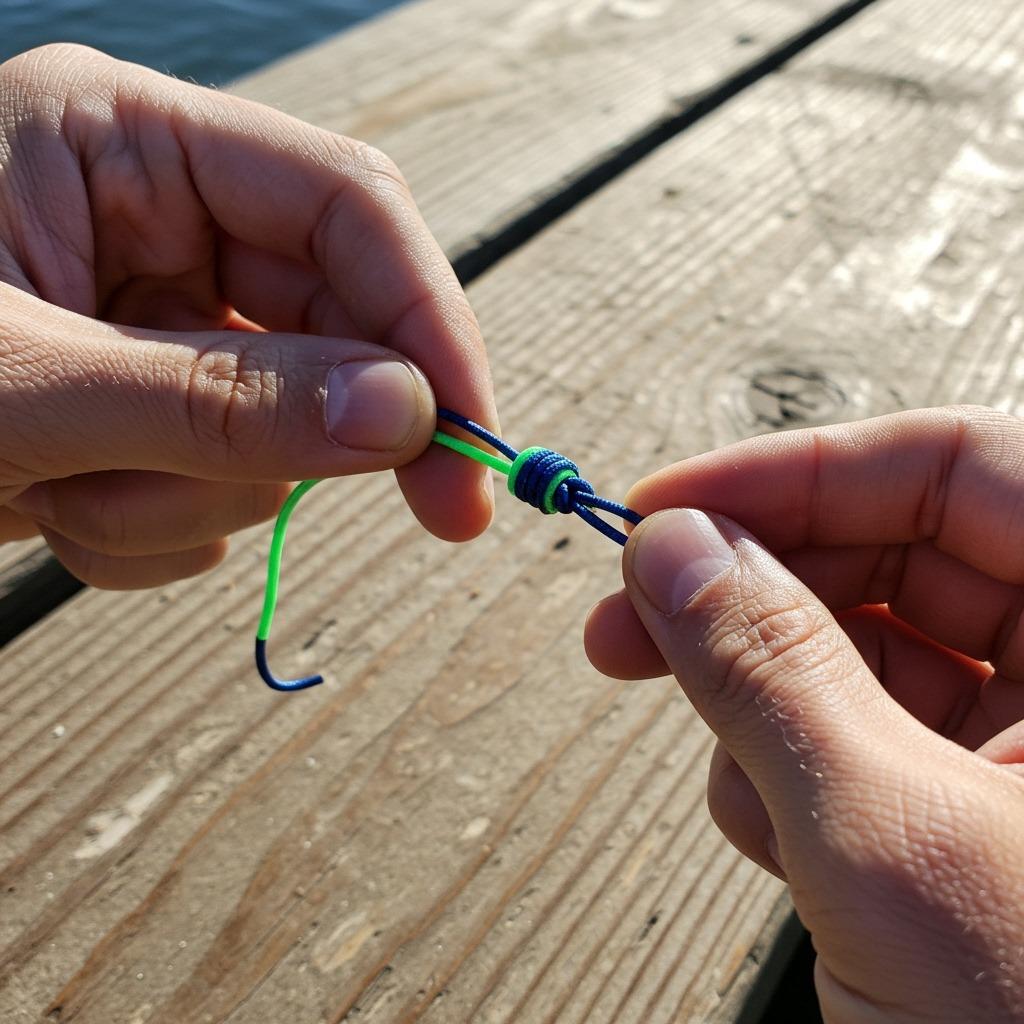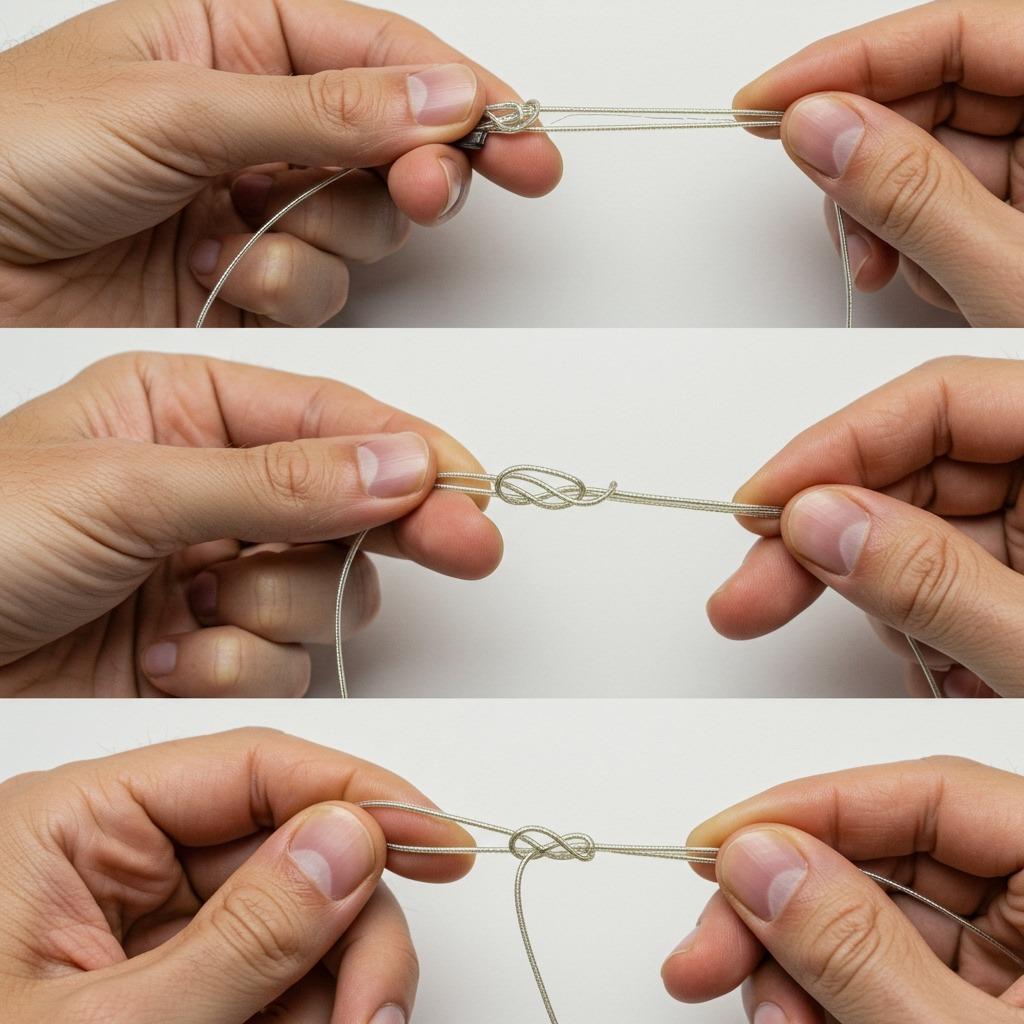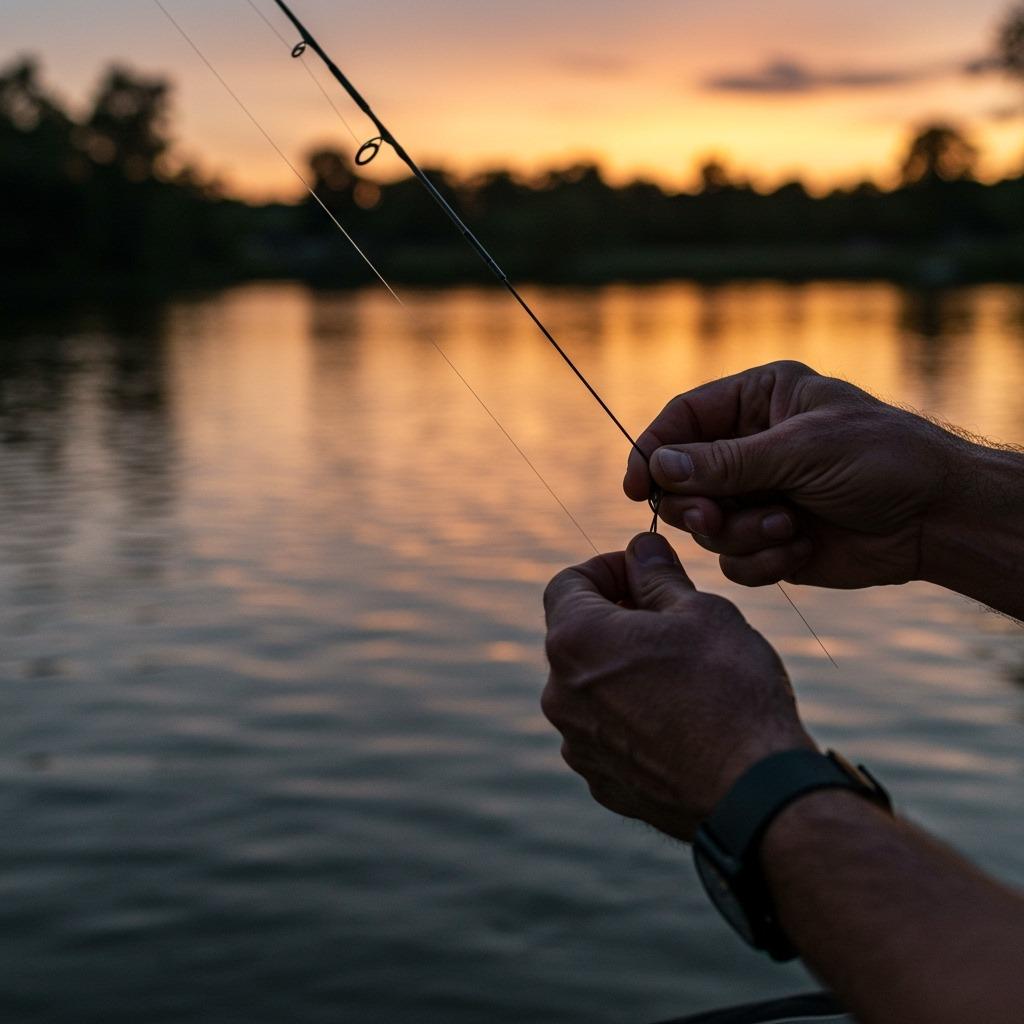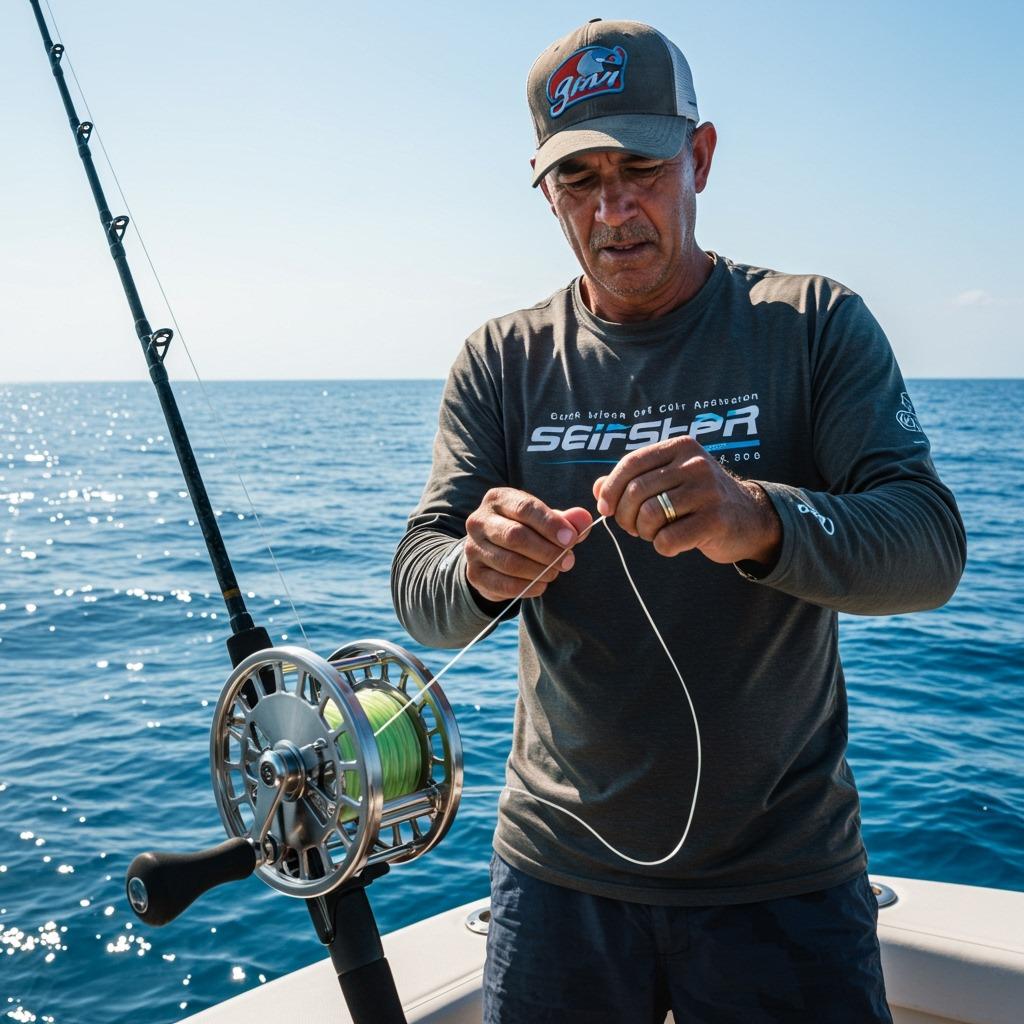I’ll never forget the moment when a massive bass took my lure during a tournament last spring. After a five-minute battle, I felt that sickening sensation of suddenly losing tension. When I reeled in my line, I discovered my knot had failed at the worst possible moment. That fish would have been my tournament winner, but my poor knot choice cost me everything. That’s when I realized that knowing how to properly tie fishing lines together isn’t just a nice skill to have—it’s absolutely essential for any serious angler.
Whether you’re connecting your main line to a leader, joining two different types of fishing line, or repairing a break in your line, the knot you choose can make or break your fishing success.
The Quick Answer: Top 5 Line-to-Line Knots
The best knots for tying fishing line together depend on your specific situation, but here are the top five options:
- Double Uni Knot – Most versatile and beginner-friendly
- FG Knot – Strongest option for braid to leader connections
- Blood Knot – Best for lines of similar diameter
- Surgeon’s Knot – Quickest and easiest to tie
- Albright Knot – Ideal for connecting lines of different diameters
Each knot has specific strengths and applications, and understanding when to use each one will dramatically improve your fishing success rate.

Understanding Line-to-Line Connections
Why Proper Knots Matter
According to knot strength testing conducted by Berkley, the connection between your main line and leader is often the weakest point in your entire fishing setup. A poorly tied knot can reduce your line strength by up to 50%, while a properly tied knot maintains 90-100% of the original line strength.
The connection point between different fishing lines experiences unique stresses during casting, fighting fish, and retrieving lures. Unlike terminal knots that connect to hooks or lures, line-to-line knots must accommodate the different properties of dissimilar materials—such as the stretch characteristics of monofilament versus the no-stretch properties of braided line.
Different Line Types and Their Challenges
Monofilament to Monofilament: These connections are generally the easiest to tie because both lines have similar properties. The stretch and flexibility of mono allow knots to cinch down evenly.
Fluorocarbon to Fluorocarbon: Similar to mono connections, but fluorocarbons’ stiffness requires extra attention to proper tightening techniques.
Braid to Monofilament/Fluorocarbon: The most common and challenging connection. Braid’s thin diameter and slick surface can cause traditional knots to slip if not tied properly.
Different Diameter Lines: Connecting 10lb test to 20lb test, for example, requires special consideration as the thinner line can cut into or slip against the thicker line.
The Double Uni Knot: The All-Around Champion
The Double Uni Knot consistently ranks as the most versatile line-to-line connection for good reason. It works effectively with all line types and maintains approximately 85-90% of original line strength across different combinations.
When to Use the Double Uni Knot
This knot excels in situations where you need reliability without complexity:
- Connecting braid to fluorocarbon leaders
- Joining lines of different diameters
- Emergency repairs on the water
- Situations where you need to tie quickly
Step-by-Step Tying Instructions
Step 1: Overlap your two lines by about 6 inches, positioning them parallel to each other.
Step 2: Take one line and form a loop, bringing the tag end back parallel to the standing line.
Step 3: Thread the tag end through the loop 5-7 times (use fewer wraps for thicker lines, more for thinner ones).
Step 4: Wet the knot and pull the tag end to snug the coils together, but don’t fully tighten yet.
Step 5: Repeat the same process with the other line, wrapping in the opposite direction.
Step 6: Wet both knots thoroughly and pull both standing lines to bring the knots together.
Step 7: Trim the tag ends close to the knots.
Pro Tips for the Double Uni
- Use 7 wraps for lines under 15lb test, 5 wraps for heavier lines.
- Always wet the knot before final tightening to prevent heat damage.
- Pull steadily rather than jerking to ensure proper seating.
- The finished knot should be symmetric, with both uni knots touching.

The FG Knot: Ultimate Strength Champion
Professional anglers and fishing guides worldwide consider the FG Knot the gold standard for braid-to-leader connections. Testing consistently shows it maintains 95-100% of line strength while creating the slimmest profile of any line-to-line knot.
Why the FG Knot Dominates
The FG Knot’s unique construction creates a connection that’s often stronger than the line itself. The braid effectively “grips” the leader through a series of interlocking loops, distributing stress across multiple contact points rather than concentrating it in one area like traditional knots.
Strength: Maintains 95-100% of line strength
Profile: Extremely slim, passes through guides easily
Versatility: Works with all braid to mono/fluoro combinations
Casting: Improves casting distance due to reduced wind resistance
FG Knot Tying Process
Step 1: Create tension on your braid by holding it taut or using a knot-tying tool.
Step 2: Thread your leader over and under the braid alternately, creating 20-30 wraps (more for lighter leaders).
Step 3: Maintain steady tension while wrapping to ensure even coil spacing.
Step 4: Finish with a series of half-hitches using the leader around the braid.
Step 5: Lock everything down with final securing wraps.
Step 6: Trim tag ends very close to avoid snags.
FG Knot Challenges and Solutions
The FG Knot’s reputation for difficulty often discourages anglers, but understanding common problems helps:
Problem: Knot slips during tightening
Solution: Maintain consistent tension and use enough wraps for your line combination
Problem: Rough finish that catches on guides
Solution: Trim tag ends closer and ensure even wrap spacing
Problem: Takes too long to tie
Solution: Practice at home and consider using a knot-tying tool for speed
Many anglers find that learning how to use trekking poles or other outdoor skills requires similar patience and practice—the FG Knot rewards persistence with superior performance.
The Blood Knot: The Classic Choice
The Blood Knot has earned its place as a favorite among fly fishermen and traditional anglers for over a century. When tied properly, it creates one of the smoothest, most streamlined connections possible.
Blood Knot Applications
This knot works best when connecting lines of similar diameter and material:
- Building tapered leaders for fly fishing
- Connecting backing to fly line sections
- Joining monofilament sections in conventional fishing
- Situations requiring an ultra-smooth connection
Blood Knot Technique
Step 1: Overlap 5-6 inches of both lines.
Step 2: Wrap one tag end around the other standing line 5-7 times.
Step 3: Thread the tag end through the gap between the lines at the starting point.
Step 4: Repeat the wrapping process with the second tag end, going in the opposite direction.
Step 5: Thread the second tag end through the same gap, but from the opposite side.
Step 6: Wet thoroughly and pull both standing lines simultaneously.
Step 7: Trim tag ends flush with the knot body.
Blood Knot Tips for Success
- Use equal numbers of wraps on both sides for balance.
- Keep wraps neat and parallel for maximum strength.
- The more similar the line diameters, the stronger the connection.
- Practice this knot at home—it’s tricky to tie in windy conditions.
The Surgeon’s Knot: Speed and Simplicity
When time is critical and you need a reliable connection fast, the Surgeon’s Knot delivers. This knot consistently tests at 90-95% of line strength while taking less than 30 seconds to tie.
Surgeon’s Knot Advantages
Speed: Fastest reliable line-to-line connection
Strength: Maintains 90-95% of original line strength
Simplicity: Easy to remember and tie in poor conditions
Versatility: Works with most line type combinations
Quick Surgeon’s Knot Method
Step 1: Overlap lines by 8-10 inches.
Step 2: Treat both lines as one and tie a simple overhand knot, leaving a large loop.
Step 3: Pass both tag ends through the loop a second time.
Step 4: Wet the knot and pull all four ends simultaneously to tighten.
Step 5: Trim excess material from both tag ends.
Surgeon’s Knot Variations
Double Surgeon’s: Two passes through the loop (standard version)
Triple Surgeon’s: Three passes for extra security with slippery lines
Water Knot: Alternative name used in fly fishing circles
The simplicity of the Surgeon’s Knot makes it particularly valuable when you’re dealing with camping in the rain or other challenging outdoor conditions where dexterity might be compromised.

The Albright Knot: Connecting Different Diameters
The Albright Knot specializes in situations where you need to connect lines of significantly different diameters or materials. It’s particularly effective for attaching backing to fly lines or connecting heavy shock leaders to lighter main lines.
Albright Knot Applications
- Connecting 10lb braid to 30lb fluorocarbon leader
- Attaching backing to fly lines
- Joining wire leaders to monofilament
- Any situation with significant diameter differences
Albright Knot Process
Step 1: Form a loop with the heavier line, leaving about 4 inches of working length.
Step 2: Thread the lighter line through the loop and back parallel to itself.
Step 3: Wrap the lighter line around both legs of the heavier line’s loop 10-12 times.
Step 4: Thread the tag end back through the loop, entering from the same side it originally went through.
Step 5: Wet thoroughly and pull the standing line of the lighter material while holding the heavier line’s loop.
Step 6: Slide the wraps tight against the loop and trim both tag ends.
Advanced Knots: The J Knot
The J Knot represents a hybrid approach, combining elements of the Uni Knot and improved clinch knot to create a connection that’s both strong and relatively easy to tie. Captain Tom Rowland popularized this knot for braid-to-fluorocarbon connections.
J Knot Construction
Step 1: Overlap your lines with about 8 inches of working length.
Step 2: Form a simple loop with both lines treated as one.
Step 3: Create a Uni Knot with the fluorocarbon through this loop.
Step 4: Use the braid to tie an improved clinch knot around the fluorocarbon.
Step 5: Tighten both knots simultaneously by pulling the standing lines.
J Knot Benefits
- Creates a smooth ramp that guides through the rod guides easily
- Strong connection suitable for large fish
- Faster to tie than an FG knot with comparable strength
- Works well with all braid-to-leader combinations
Knot Strength Testing and Real-World Performance
Understanding knot strength data helps you make informed decisions about which knots to use in different situations.
Laboratory vs. Real-World Conditions
Laboratory testing provides valuable baseline data, but real-world fishing presents additional challenges:
- Abrasion resistance: How well knots hold up against rocks, structure, and fish teeth
- Shock loading: Sudden stress from hooksets and fish runs
- Water temperature effects: Cold water can make some knots more brittle
- UV exposure: Sunlight degrades line strength over time
Strength Testing Results
According to comprehensive testing by multiple organizations:
FG Knot: 95-100% strength retention
Double Uni: 85-90% strength retention
Blood Knot: 80-90% strength retention (similar diameter lines only)
Surgeon’s Knot: 85-95% strength retention
Albright Knot: 75-85% strength retention
Factors That Affect Knot Performance
Line Material Considerations
Monofilament: Generally forgiving and easy to tie knots with. Heat buildup during tightening is the primary concern.
Fluorocarbon: Stiffer and more abrasion-resistant than mono, but requires more attention to proper tightening techniques. Memory in the line can cause some knots to loosen over time.
Braided Line: Exceptional strength, but can be slippery. Some traditional knots don’t hold well with braid, requiring specialized techniques or additional wraps.
Environmental Factors
Water Temperature: Cold water makes lines stiffer and more prone to breaking during tying. Warm your hands and work slowly in cold conditions.
Humidity: High humidity can make some lines more slippery and harder to grip during knot tying.
Wind: Affects your ability to control loose line ends during tying. Learn to tie with minimal loose line exposed.
Line Condition and Age
UV Damage: Ultraviolet light breaks down line strength over time. Replace leaders regularly, especially for saltwater fishing.
Abrasion Damage: Even minor nicks can significantly weaken the line at knot points. Inspect your line regularly and retie when necessary.
Memory: Old line develops memory that can affect how knots seat and hold. Fresh line almost always performs better.
Specialty Applications and Situations
Saltwater vs. Freshwater Considerations
Saltwater environments demand extra knot security due to:
- Larger, stronger fish that create more stress
- Corrosive salt that can weaken connections over time
- Abrasive structures like coral and rocks
- Greater consequences of equipment failure in offshore situations
Freshwater fishing often allows for lighter connections but still requires:
- Consideration of structures like fallen trees and rocks
- Sharp-toothed species like pike and musky that can cut lines
- Clear water conditions where visible knots might spook fish
Tournament and Competition Fishing
In competitive situations, knot reliability becomes even more critical:
- Use proven knots you’ve practiced extensively
- Retie connections more frequently than in casual fishing
- Consider the time investment—a slow knot might cost fishing time.
- Account for stress and adrenaline affecting your tying ability
When you’re bass fishing in tournaments, the pressure can make even simple tasks more difficult, so practicing knots until they become automatic is essential.
Offshore and Big Game Applications
Large ocean fish create extreme stress on tackle connections:
- Use the strongest knots possible (FG, Bimini Twist combinations)
- Inspect connections frequently during long fights.
- Consider backing up critical connections with additional security.
- Account for the abrasive effects of sand, salt, and fish skin

Common Knot-Tying Mistakes and How to Avoid Them
The Top 5 Knot Failures
1. Insufficient Lubrication
Dry knots generate heat friction during tightening, which can melt and weaken the line. Always wet knots with water or saliva before final tightening.
2. Uneven Tightening
Pulling too hard on one component while the other remains loose creates uneven stress distribution. Pull smoothly and evenly on all components.
3. Wrong Knot for the Application
Using a knot designed for similar diameter lines on drastically different sizes, or using freshwater knots in saltwater situations.
4. Poor Tag End Management
Leaving tag ends too long creates snags and tangles. Trimming too close weakens the knot. Leave about 1/8 inch of tag end for most applications.
5. Inadequate Testing
Not checking knot integrity before fishing. Always pull-test your knots firmly by hand before trusting them with fish.
Quality Control Checklist
Before trusting any line-to-line connection:
- Visual inspection: The Knot should look symmetrical and properly seated
- Pull test: Gradually increase tension to test holding power.
- Smoothness check: Run your finger along the connection to feel for rough spots
- Guide test: Make sure the knot passes smoothly through your rod guides
Tools and Accessories for Better Knot Tying
Essential Knot-Tying Tools
Knot Tying Tools: Specialized tools like the FG Knot Assist make complex knots much easier and faster to tie.
Nail Knot Tools: Originally designed for fly fishing, but useful for many line-to-line connections.
Line Clippers: Sharp, precise cuts prevent line fraying that can weaken knots.
Headlamps: Proper lighting is crucial for tying knots in low-light conditions.
Improvised Tools
When you don’t have specialized equipment:
- Use a small stick or pen as a nail knot tool substitute
- A braid can serve as a loop-holding aid for complex knots.
- Needle-nose pliers help with final tightening and tag-end trimming.
Understanding how to improvise with available tools becomes particularly important during primitive camping trips where you might not have access to all your usual fishing accessories.
Maintenance and Inspection
When to Retie Connections
After Every Fish: Large fish put significant stress on knots. Inspect and retie if you notice any damage.
Daily: Check connections at the start of each fishing session, especially the first connection point.
After Snags: Any time your line gets hung up and you have to pull hard, inspect all connections afterward.
Preventive Schedule: Consider retying leader connections every few hours of active fishing.
Signs a Knot Needs Replacement
- Visible fraying or damage to the line near the knot
- The knot looks deformed or has shifted from its original shape.
- The line shows stress marks like whitening or kinking.
- Any part of the connection feels rough when run through your fingers.
- The knot has been subjected to sudden shock loading.
Knot Selection Guide by Fishing Situation
Quick Reference Chart
Braid to Fluorocarbon Leader: FG Knot (best) or Double Uni (easier)
Similar Diameter Lines: Blood Knot or Surgeon’s Knot
Emergency Repairs: Surgeon’s Knot or Double Uni
Fly Fishing Leaders: Blood Knot or Surgeon’s Knot
Large Diameter Differences: Albright Knot
Speed Critical: Surgeon’s Knot
Maximum Strength Needed: FG Knot or Bimini Twist + Albright
Beginner-Friendly Progression
If you’re new to line-to-line knots, master them in this order:
- Surgeon’s Knot: Build confidence with something simple and reliable
- Double Uni Knot: Learn the most versatile connection
- Blood Knot: Develop precision with a traditional favorite
- FG Knot: Tackle the strongest option once fundamentals are solid
Troubleshooting Common Problems
“My Knots Keep Slipping”
Likely Causes:
- Insufficient wraps for your line combination
- Not wetting the knot before tightening.
- Using the wrong knot for slippery line types
- Pulling too quickly during tightening
Solutions:
- Add 2-3 extra wraps to your standard technique
- Always lubricate before final tightening.
- Switch to knots specifically designed for slippery lines.
- Tighten gradually with steady pressure.
“My Connections Look Messy”
Likely Causes:
- Uneven wrap spacing during tying
- Inconsistent tension while forming the knot
- Wrong line management during the process
Solutions:
- Practice tying knots at home with colored lines to see mistakes clearly.
- Focus on maintaining consistent tension throughout the process.
- Use your fingers to keep wraps neat and parallel.
“I Can’t Remember the Steps”
Solutions:
- Practice one knot at a time until it becomes automatic
- Use mnemonic devices or verbal cues for complex knots.
- Keep a knot reference card in your tackle box.
- Practice in good conditions before trying in challenging situations
For those who enjoy systematic skill-building, learning fishing knots follows similar principles to mastering other outdoor skills like reading topographic maps—consistent practice and understanding the fundamentals make complex techniques much more manageable.
Frequently Asked Questions
What’s the strongest knot for tying two fishing lines together?
The FG Knot consistently tests as the strongest line-to-line connection, maintaining 95-100% of original line strength. However, the “best” knot depends on your specific situation—the Double Uni Knot might be better if you need something reliable that’s easier to tie quickly.
Can I use the same knot for all line combinations?
While the Double Uni Knot works for most situations, different line types and applications benefit from specific knots. Braid-to-fluorocarbon connections work best with FG or specialized braid knots, while similar diameter mono lines work great with Blood Knots.
How often should I retie my line-to-line connections?
Retie connections after landing large fish, after your line gets snagged and stressed, and as a general practice, every few hours of active fishing. For tournament or important fishing, consider retying at the start of each session.
Why do my knots keep breaking?
Common causes include not wetting the knot before tightening (causing heat damage), using insufficient wraps for your line type, tightening unevenly, or choosing the wrong knot for your line combination. Make sure to lubricate and tighten gradually.
What’s the easiest strong knot for beginners?
The Surgeon’s Knot offers the best combination of strength (90-95% line strength), speed, and simplicity for beginners. It works with most line combinations and can be tied reliably even in challenging conditions.
Mastering line-to-line connections transforms your fishing from hoping your knots hold to knowing they will. Whether you’re connecting braid to a fluorocarbon leader for bass fishing or joining sections of line during surf fishing, the right knot tied properly makes all the difference between landing that fish of a lifetime and telling another story about the one that got away.
Remember: the best knot is the one you can tie correctly every time under any conditions. Master a few reliable options rather than trying to learn every knot variation, and your time on the water will be much more productive and enjoyable.
